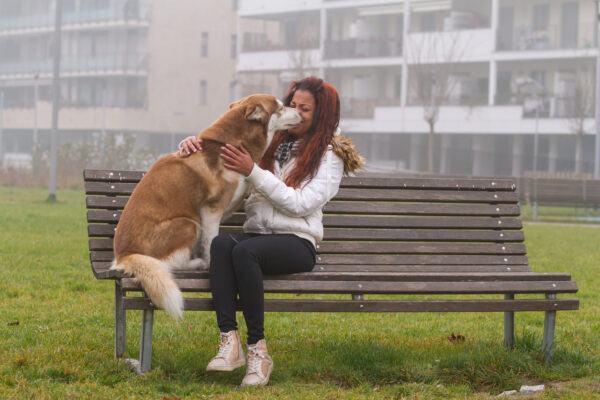SIGNS YOUR PET IS DYING
We all wish our fur babies could live as long as us. However, we have to accept the inevitable and prepare ourselves for that moment. Knowing when that moment is upon us is difficult. Here are some signs that might tell you the time is approaching. Make every moment together count and create some everlasting pet memorials with each other.
The Physical Signs

Each breed has its own life expectancy, and we can make an educated guess based on that and your pet’s health. So, being watchful of physical signs or changes in how your pet is feeling will help you prepare in advance and help ensure their last days are full of love and care.
Changes in Appetite and Thirst
Our bodies tell us when we are in our final days, and pets are no different. There could be a loss of appetite and thirst, especially if they are uncomfortable or have nausea or pain. Experiencing gastrointestinal symptoms can further diminish the urge to eat or drink.
Dull Eyes
Like people, your pet’s eyes can start to fail near the end of life. You may notice cloudy eyes or have trouble seeing. By itself, dull eyes could be a sign of age or an eye condition; however, when taken with other signs, it could mean something more.
Decreased Grooming
If your pet is too tired or in too much pain or discomfort, their normal grooming habits will decrease. Their coat may start to look unkempt or dull. You can help them out with a gentle brushing or warm bath.
Increased Body Odor
As your pet nears the end of life, you may notice different or stronger odors than usual. Their body stops functioning like normal due to metabolism changes, illness, poor grooming, dental disease, or incontinence, among others.
Loss of Mobility or Coordination
Watching your pet grow into their senior years can be saddening, knowing goodbye lies ahead. They may no longer be able to participate in their usual activities or struggle to keep up with daily routines. As your pet grows weaker in their final days, there may be a loss of balance, shakiness, and disorientation. If possible, limit their area help them with their daily needs, and keep them clean and comfortable.
Difficulty Breathing or Rapid Breathing
It is very heart-wrenching to watch your beloved best friend struggling to breathe. You may notice faster or slower breath rate or even hear the sound of their breathing get harsher or quieter. Let them know you love them and be near them.
Seizures
It is not uncommon for pets to start having seizures as they near the end of life, including twitching or involuntary muscle spasms. This can be the result of metabolic body changes, organ issues, or problems in the brain. During these episodes, keep them safe and away from harmful objects, gently hold their head, and offer loving comfort until it passes.
Vomiting
Throughout your companion’s life, they probably experienced occasional bouts of vomiting or diarrhea. This is common. Persistent and uncontrollable episodes can be a sign of illness and indicate whether the digestive system is working normally or shutting down. Seek veterinary attention if these symptoms persist.
Incontinence or Diarrhea
Similar to vomiting, if your pet is experiencing severe diarrhea combined with other symptoms, the digestive system may not be working correctly and shutting down. If untreatable by your veterinarian, be patient and compassionate. Your pet may need extra help moving and staying clean. It is important to keep your pet hydrated with water or broth if experiencing diarrhea or vomiting.
Extreme Weight Loss or Weight Gain
Many pets in their senior years will have a slightly reduced appetite and may lose weight. Extreme weight loss or weight gain could be a sign of cancer, disease, diabetes, or another serious ailment that you might need to consult with your veterinarian about.
Noticeable Changes in Body Temperature
As your pet ages, hormonal changes can make it difficult for them to regulate body temperature. If your loved one is sick or nearing the end of life, you may notice them getting hotter or colder than they used to. You can provide your pet comfort by avoiding extreme temperatures and cooling them when hot or warming when cold.
Withdrawn or Decreased Responsiveness
As your pet’s health declines, they may start to show a lack of interest in what’s happening around them. Things that sparked excitement, like treats, toys, and eagerness to see family members, may not rouse much enthusiasm anymore. Let your pet rest where they feel at peace and safe.
Behavioral Signs

If your pet just isn’t acting like themselves, it can be a sign of failing health. Whether it is spending a lot of time alone, resting in unusual spots or lack of energy, don’t pressure them to get active. Instead, give them their space to relax.
Spontaneous Crying
If only they could tell you how they feel. Instead, it is up to us to interpret their signs. Spontaneous crying could be due to being uncomfortable and unable to settle down and rest. The feeling of pain and discomfort, and not understanding it themselves, can lead to them being vocal.
Restlessness or Pacing
Pets can show a variety of behavioral changes when nearing the end-of-life journey. Some pets become restless, wandering around the house and pacing back and forth.
Changes in Sleep Patterns
Your pet’s sleeping patterns may change including sleeping more often as their energy level decreases.
On the flip-side, they may become cranky and irritable due to lack of sleep and being in discomfort.
The Emotional Signs

As our constant companions, we are in sync with our pet’s moods and are on the lookout for anything upsetting them. Like us, our pets can go through emotional distress when they are not feeling like they should.
Loss of Interest or Interaction
Endless hours of chasing squirrels or birds, playing with pet siblings, and greeting visitors at the door. These activities may not captivate your pet’s attention anymore as it ages. As it nears the end of its life journey, you may see it want to isolate itself more in a different area. Give them the space they need while monitoring their health.
Acting Anxious or Fearful
We don’t know exactly how a pet is feeling. Just imagine if your pet doesn’t know what is happening to themselves. This can be very stressful for them and cause them to be anxious or fearful. This is especially true if your pet is in pain. Symptoms of anxiety can include whining, pacing, crying, or panting. Sometimes, anxiety can be worse than pain. Try to help your pet feel calmer and more at ease.
Looking for Hiding Places
Pets love nothing more than to be near their loved ones. So, one of the clearest signs of the end of life is showing detachment. It could be as subtle as going to another room, or it could be as dramatic as hiding in a closet or underneath an object. This is a natural instinct for some pets, so be understanding.
Frequently Seeking to be Comforted
Conversely, some pets know their time is approaching and will look to their family for comfort. Instead of wanting to hide, they want you to reassure them with gentle stroking and a soft word. The best thing is to shower your pet with love and be their “rock”.
How to Provide Comfort to a Dying Pet

Saying farewell to your pet with love and grace means staying with them during these final hours. Your presence is enough to show how much they are loved. However, make sure they are comfortable in a calm and quiet environment.
Palliative Care
The goal of palliative care is to minimize your pet’s discomfort in the final days.
Creating a Supportive Environment
Stick to regular routines in familiar places to minimize stress. Avoid unnecessary stress by maintaining a peaceful environment and avoiding disturbances. Your presence can help keep your pet calm, even if it is just sitting next to you.
Consult with a Veterinarian for Guidance
While the symptoms listed above can be signs that a pet is dying, they can also be signs of treatable medical conditions. It is best to visit your veterinarian for an examination, and your vet can discuss care options at this time.
Knowing How & When to Say Goodbye
We all wish our pets would pass peacefully at home, but that is not always the case. When the bad days outnumber the good, it may be time to make a difficult decision to say goodbye. In the meantime, make the most of the time left together by spoiling your pet and creating ways to memorialize them in your heart.
Tranquil Tides Provides Compassionate Water-Based Cremation
Before you say goodbye to your family member, take a moment to consider how you’d like to memorialize your pet. Tranquil Tides offers pet memorial keepsakes and custom picture urn engraving, and we are here to assist you in your time of need.
Recent Posts
The Gentle Pet Cremation Choice For Exotic Pets: Pet Aquamation
The Gentle Pet Cremation Choice for Exotic Pets: Pet Aquamation! For owners of exotic pets, the loss of a [...]
Choosing the Right Type of Pet Aquamation or Pet Cremation Establishment: A Guide for Pet Owners
Choosing the Right Pet Aquamation or Pet Cremation Establishment: A Guide for Pet Owners Losing a beloved pet is [...]
Pet’s Remains After Aquamation
What Happens to a Pet’s Remains After Aquamation Aquamation, or cremation by water, is a highly sustainable option that allows [...]
How to Cope with Pet Loss
How to Cope with Pet Loss No one person will experience grief the same when coping with a dying [...]








